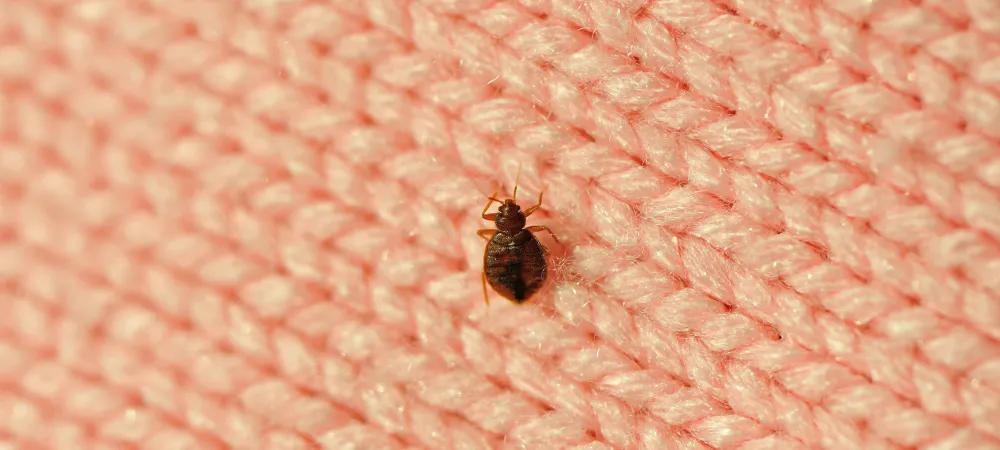Everything You Need to Know About Bed Bugs

Waking up with a line of itchy red bites can be very unsettling. Whether you’re groggy or fully awake, you may start to wonder what bit you, if it’s dangerous or if there are more bites to come! With the information below, you can make a very educated guess whether you’ve been bitten by bed bugs and find out more about the steps to take to get rid of them around your home.
What Do Bed Bugs Look Like?
Bed bugs are reddish-brown insects, with adults being about as big as an apple seed. Adult bed bugs are just under 1/4" long, relatively flat, and oval in shape compared to most other insects. They have 6 legs and a large abdomen that has horizontal stripes running across the back. Two antennae are also located at the front of their heads, branching sideways.
Being so small, bed bugs are difficult to spot. Bed bugs molt their skin and transform through 5 stages of growth before reaching full maturity. Bed bug nymphs begin at about 1 mm in size and are paler and translucent in appearance. They slowly become browner as they emerge from previous exoskeletons and grow in size.
What Do Bed Bug Bites Look Like?
These pests leave bites that look red and swollen, with swelling affecting people differently based on their skin sensitivities. Commonly bed bug bites may form a line or a zigzag pattern. Though bites vary in size, scratching them can lead to more inflammation and lead to bigger patches. If you are waking up with red, swollen welts on your body abed bug inspection is the next step.
Are Bed Bug Bites Poisonous?
Bed bugs may cause allergic reactions to a small population of people, but their bites are not poisonous to humans and do not spread diseases like other bugs do when they bite. So, while these bites are uncomfortable your health isn't at immediate risk.
Where Do Bed Bugs Typically Bite?
Bed bugs prefer exposed areas of skin, typically along the arms, legs, neck, back, and shoulders. They can also crawl over your clothes and find more skin to bite.
Bed Bug Facts
- Bed bugs draw blood for about five minutes before retreating to digest.
- Bed bug hatchlings are so small they can pass through a stitch-hole in a mattress.
- Bed bugs can ingest seven-times their own weight in blood, which would be the equivalent of an average-sized male drinking 120 gallons of liquid.
- Bed bugs can lay one to five eggs per day and more than 500 in a lifetime.
- Bed bugs can survive for several months without eating.
- Bed bugs can withstand a wide range of temperatures, from nearly freezing to 122 degrees Fahrenheit.
What to Know About Bed Bugs While Traveling
- As soon as you get to the hotel, check the seams of the mattress and box spring for signs of bed bugs. Look for live bugs hiding along seams, eggs, and also bed bug spotting which will look like the tip of a sharpie has touched the mattress. Check behind the headboard for bed bugs and eggs as well. If anything is in question, contact the front desk immediately.
- Make sure to check with the Bed Bug Registry to see if your hotel has had issues with bed bugs in the recent past.
- Never leave your suitcase or belongings on the floor or near the bed. Keep them up off the ground on the desk or on the rack they provide. This limits the chances of bed bugs moving into your luggage to travel back home.
- When you return home, keep your suitcase in the garage and take all clothing straight into the laundry. Placing clothing in the dryer on high heat for a half-hour will kill any bed bugs that could have come back. Inspect the seams of the suitcase for any bed bugs or eggs once you are done laundering.
How to Prevent Bed Bugs
There are several steps you can take to help prevent bed bugs in your everyday life. Regular bed bug inspections are the best line of defense to help you avoid a bed bug infestation.
Here are some other prevention tips to keep in mind:
- Regularly inspect areas where pets sleep for signs of bed bugs such as pepper-like stains, molted bed bug skins, and white, sticky eggs.
- Never bring second-hand furniture, especially mattresses and box springs, into a home or college dorm without thoroughly examining it for signs of a bed bug infestation.
- Wash all clothes – even those that have not been worn – in hot water and dry them using an extra-hot dryer setting
If you are concerned that you may have found bed bugs or have brought them back from your vacation or travels, don't hesitate to give the bed bug exterminators at Eco Serve Pest Services a call at [phone-number] to help you.
Contact Your Local Bed Bug Exterminators
If you notice bed bugs around your home DIY bed bug control methods just won't do. They can actually lead to more issues in your home. Contact your local bed bug professionals at Eco Serve Pest Services and we can take care of your infestation within 48-hours.

